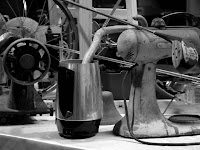
Today we gave more consideration to negative areas in our work, and when we start working with the model, the importance of negative shapes becomes even greater because those areas tell us so much about the proportions of the figure. All of the surface areas in a drawing contribute to total unity. Those areas that represent your initial selection of forms are called positive shapes, such as the sewing machine or the frames, "unoccupied" areas around those forms are called negative shapes. The negative shapes are just as important to total image unity as the positive shapes, which seem tangible and more explicitly drawn. Positive/Negative is also referred to as figure/ground.
The term positive/negative was first introduced to you during your foundations experience, probably in F100. It's an important concept to beginners investigating composition because the lack of compositional experience tends to direct the beginning student's attention to positive forms, while neglecting the surrounding shapes. We're past that now, so instead of the overcrowded, busy, and confusing imagery that results from neglected negative shapes, as we often see in F100, we're orchestrating our images to a more unified and integrated place, but we have to be more aware of how those shapes function in our work
When your drawing utensil first touches the picture plane, your piece of paper, leaving a mark, two things happen. First, the mark divides to some extent the picture place. The mark is seen as a positive image leaving the remainder to be perceived as a negative shape. Secondly, the mark instantaneously takes a position in space with respect to the picture plane. Each of these two factors should continue to be an important consideration for you as your image develops.
You can kind of think about it like this: when you're hanging a picture on your wall, you consider the placement of that picture relative to the size of the wall and its general location to windows, furniture, and maybe even other pictures. You're considering the negative space and how it work in relation to the positive, the picture. Keep thinking, and have a good weekend.

Shawn was a huge help to me today to stay focused on the negative space. I really started out trying to draw the negative space, but, instinctively went back to the positive shapes. He got me back on track and although my drawing was far from perfect I did have it in a completed state by the end of class. And it was probably one of the most unique backgrounds that I've done yet.
ReplyDeleteI do think I'll be working on that over the weekend. Doing drawings from the negative standpoint as much as possible.
I am usally decent at negative space drawings but today I could not stay focused. I don't know if it was the subject matter or the nine in the morning but it was not working for me.
ReplyDeleteI was disappointed with my negative space when I looked at my finish drawing. I wish I would have concentrated more on what was behind the bike as opposed to just coloring it in as if nothing was there.
ReplyDeleteI really felt like for once that I produced a drawing in class that I am proud of. Usually I like what I do outside of class better. I really liked this assignment.
ReplyDeleteThis project I thought I did well on the positive, but I still have some trouble with the negative. I should have zoomed in more on the picture, I think that would have helped.
ReplyDeleteI enjoyed the still life with the striped cloth a lot more. I think it was because there was so much to take in with this still life that my eyes didn't want to stay focused on just one portion of it. Also I think that if I had drawn on a larger scale, I would have been able to complete it.
ReplyDeleteLooking back at this drawing session, i really liked the final result. I am with tatum, i usually don't like what i draw in class and i prefer to seclude myself in my studio while i work. Unfortunately, I wish i used a better quality paper for this drawing. But, that's how you learn, from making horrible mistakes!
ReplyDelete